Odisha’s Fight against COVID-19
By Amarendra Das and Subrat K Mishra
Introduction
In the fight against COVID-19, Odisha is leading from the front along with Kerala. The state has received compliments from the national government, and national and international media. Unlike Kerala, Odisha’s per capita income is only around Rs 1,05,000 against the national average of Rs. 1,35,000 and that of Kerala Rs 1, 84, 000. In spite of the low level of economic progress and human development, Odisha has always drawn global attention in disaster management; be it a natural disaster or a health disaster like COVID-19. In this context, here we present the Odisha’s fight against the current pandemic.
COVID-19 Cases in Odisha
Figure 1 shows the district wise and total number of infected cases, active cases and recovered cases and number of deaths as on April 29, 2020. Figure 2 illustrates the trend of COVID-19 cases in Odisha.
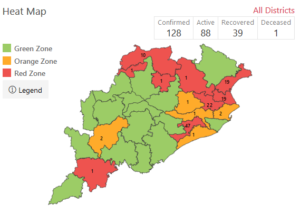
Source: COVID-19 Dashboard, Govt. of Odisha https://statedashboard.odisha.gov.in/
Figure 1: COVID-19 cases in Odisha
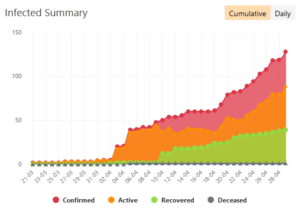
Source: COVID-19 Dashboard, Govt. of Odisha https://statedashboard.odisha.gov.in/
Figure 2: Trend of COVID-19 cases in Odisha
Sendai Framework for Disaster Management
In order to have a better understanding of Odisha’s disaster management, we need to analyse this in the perspective of Sendai Framework for Disaster Risk Reduction (SFDRR) 2015-30 to which India is a signatory member. The SFDRR, which aims to guide multi-hazard management, including a biohazard like COVID-19, of disaster risk in development 1 sets the priorities in the following order:
Priority 1: Understanding disaster risk.
Priority 2: Strengthening disaster risk governance to manage disaster risk.
Priority 3: Investing in disaster risk reduction for resilience.
Priority 4: Enhancing disaster preparedness for effective response and to ‘Build Back Better’ in recovery, rehabilitation and reconstruction.
Odisha’s frequent encounter with various natural disasters has made the state resilient. The management of cyclones and other natural disasters, such as heatwave, floods and lightning, has improved the skills of the state administration. The state is in a position to understand the risks of a disaster much better. The state administration takes a zero-casualty approach to any kind of disaster and uses the entire state administrative machinery in mission mode. Although the state has created a specialised disaster mitigation force named, Odisha Disaster Rapid Action Force (ODRAF) for the mitigation of natural disasters, the state government deploys almost all the government officials, including the fire brigade, police personnel, and teachers, in different capacities.
The 1999 super cyclone of Odisha, which took more than 10,000 lives, taught many lessons to the state and the people of Odisha. Immediately after the 1999 super cyclone, Odisha founded an autonomous institution on December 28, 1999, to manage the disasters in future and named it, Orissa State Disaster Management Authority (OSDMA). Taking a lesson from Odisha, the Government of India enacted the Disaster Management Act on December 23, 2005, which envisaged the creation of National Disaster Management Authority (NDMA), headed by the Prime Minister, and State Disaster Management Authorities (SDMAs) headed by the chief ministers, to spearhead and implement a holistic and integrated approach to Disaster Management in India. Following the enactment of the NDMA, disaster management plans have become mandatory at the national, state, and district levels. States like Odisha are also preparing disaster management plans for cyclone-prone towns and villages. Based on past learnings, people, in general, also largely extend their cooperation to the administration for effective management of the disaster.
The state government has been continuously strengthening its capacity to manage every known and unknown disaster efficiently. Although every disaster poses a new challenge before the state administration, the institutional memory in managing past disasters comes in handy. The state government is continuously investing in building up the technological capacity and capacity building of government officers, non-governmental organisations, local communities, students and youth volunteers to mitigate the disruptive effects of disasters. Similarly, the state has not only formulated disaster management plans at the state, district and village levels, but also, meticulously, revises all these plans at regular intervals keeping in view the dynamic nature of social, economic, technological, political context at the local, national and global levels.
Odisha’s Response to COVID-19
The first confirmed case of coronavirus in India was reported on January 30, 2020, in the southern state of Kerala; the patient was a female student at the Wuhan University in China. Odisha reported the first confirmed coronavirus case on March 16, 2020. The patient is a 33-year old researcher who returned from Italy to Delhi on March 6 and travelled to Bhubaneswar by train on March 12.
On March 09, 2020, Odisha established its first testing facility for COVID-19 at the Regional Medical Research Centre (RMRC) in Bhubaneswar. The state government started publishing safety measures on Corona Virus in print, electronic and social media.
Even before the first COVID-19 case was identified, the State took several measures showing its preparedness.
- The state convened an emergency meeting on March 13, 2020, of the state-level Natural Calamity Committee under the chairmanship of the Chief Minister and declared COVID-19 as a ‘state disaster’ under the provisions of Disaster Management Act 2005. A day after, the Government of India notified this as a national disaster. Following the announcement of the ‘Janta Curfew’ by the Prime Minister, the Government of Odisha announced ‘Lockdown to Knock Down’ from March 22 to March 31. It became one of the first states to do so. Following this, Prime Minister Modi announced lockdown of the country for three weeks starting from March 24, 2020.
- The state continued to approve the COVID-19 Odisha Regulations 2020 (March 13, 2020) and authorized competent officers to impose required restrictions on assemblies, congregations, institutions and establishments aiming at social distancing by invoking powers under the Epidemic Diseases Act, 1897 and the Code of Criminal Procedure, 1973. An empowered Group of Ministers was constituted, and a Committee of Secretaries under the Chairmanship of the Chief Secretary was constituted to evaluate the emerging situation and take all necessary steps for preventing, containing and mitigating the spread of COVID-19 in the state. The state sanctioned Rs 200 crores to augment the Public Health Response Fund to combat the threat of the pandemic. The state announced the closure of all educational institutions, cinema halls, swimming pools, gyms; cancelled all non-essential official gatherings, such as seminars, workshops, conferences; and, regulated all social gatherings and assemblies, like religious functions, marriage receptions and other events by the local authorities.
- Using social media, several communication tools, such as posters and videos, were shared among people to adopt proper hygiene practices to fight against COVID-19. The Chief Minister along with the ministers and MLAs demonstrated hand washing process to spread the message of the importance of doing it at regular intervals. The communications were so detailed that the Chief Minister even appealed to all Odias to stop spitting Paan.
- The CM appealed to people to practise social distancing along with hand-washing and proper sanitization of self and surrounding.
- The state launched a toll-free number 104 and a web portal for the people who had travelled outside the state to register within 24 hours of their arrival. The government officials established contact with the registered persons for detail enquiry and medical examination if required. The state also announced a cash incentive of Rs. 15, 000 (US 200 $) and medical care at home for persons registered for quarantine at home. People spreading rumours or false information were warned that they would be taken into police custody. The state also made it mandatory for people returning from abroad to register and non-compliance was made punishable under the provisions of the Indian Penal Code and Criminal Procedure Code. As on April 01, 2020, 15895 people had registered using the helpline number 104. Out of these, 4666 people had travel history abroad. In all, 245 cases have been lodged against violators of the lockdown.

With the first COVID-19 confirmed case, from March 16, the state government started special press briefing every afternoon to keep the public informed about the status of COVID-19 in the state and the measures taken. The state government also appointed a special spokesperson for this purpose. Following it, the Chief Minister wrote to the Prime Minister to defer the enumeration work of Census 2021.
Even though the total number of COVID-19 cases identified were below five then, on March 21, the CM announced a near-total lockdown of five districts with a higher number of foreign returnee migrants, namely Khordha, Ganjam, Cuttack, Kendrapara and Angul and eight towns namely Sambalpur, Jharsuguda, Balasore, Rourkela, Bhadrak, Puri, Jajapur Road and Jajapur Town. Seventy percent of the 3200 foreign returnees belonged to these districts. People were allowed to go out only for essential commodities. Buses, trains, flights, grocery shops, vegetable shops, shops selling fish, eggs, chicken, petrol pumps, medicine stores, hospitals banks, ATMs, police, fire service, ODRAF, drinking water and power supply were excluded from the lockdown. Private companies were directed to allow work from home.
On March 23, the state government launched a toll-free number ‘Sadhan’ in order to ensure the supply of essential commodities and services. The CM appealed to the people to donate generously to the Chief Minister’s Relief Fund. He donated his three months’ salary to the CMRF. The lockdown was extended from five to fourteen districts. The Chief Minister evoked an emotional response when he requested everyone in the state to take oath in the name of their children and parents not to go out of home and strictly obey the lockdown.
On March 24, in order to boost the morale of health professionals engaged in the fight against COVID-19, in Odisha, the CM announced four months advance salary for doctors, nurses and other paramedical staff. He also appealed to the people to treat the health professionals with respect and affection and warned that those misbehaving with them would be penalized.
By the second week of identification of the first COVID-19 case in the State, on March 27, the government opened a helpline number for the Odia people stranded in different states of the country. The state government announced a package of Rs 2200 crore for the food security and social welfare of poor people and construction workers. This included the advance distribution of rice for three months, Rs 1000 each to 94 lakh families, advance payment of pension to 48 lakh beneficiaries under different social security schemes, disbursement of financial assistance worth Rs 1500 to 22 lakh construction workers. The CM sought the cooperation of the senior professionals in different health and allied fields to extend their support to assist the government at the senior management level. Odisha was the first state to announce that it will take care of migrant workers from all other states living in the state and that services during the COVID-19 emergency would be provided free of cost.
Further, the government signed a Memorandum of Understanding (MoU) with two private hospitals to open dedicated COVID-19 hospitals with 650 beds on March 29. These facilities have been created with the CSR funds of Orissa Mining Corporation in partnership with private hospitals. The state was the first to do so and a day after, the Government of India requested all states to start setting up dedicated COVID-19 hospitals/wards.
By the beginning of April, the total identification of COVID-19 positive case grew to five. With the fifth case with no travel history and sixth case with the history of participation in the Tablighi Jamaat’s Markaz or congregation held at Delhi’s Nizamuddin West, the state intensified its fight against COVID-19. The state government clamped 48-hour complete shutdown or curfew in Bhubaneswar, Cuttack and Bhadrak cities to control the spread of the disease. During this shutdown, all services were suspended, excluding a few selected medical stores. Police teams in these three cities patrolled each locality intensely to ensure nobody came out and broke the curfew. During this complete shutdown, people were asked to call the police for any help, including the need for an ambulance. Post this complete shutdown, the state government identified pockets in these cities which were home to the most number of COVID-19 cases and declared these as ‘containment zones’. These containment zones were fully sealed, and no person was allowed to come out or go in. The Fire brigade along with the police started sanitization of these localities.
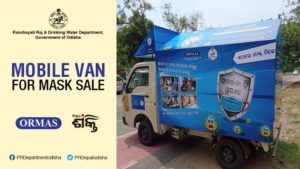 As the lockdown got stiffer, the state government started serving fresh meals to the sick, destitute, and indigent villagers across 1359 Gram Panchayats of the state. Self-Help Groups (SHGs) are engaged in serving the food, preparing masks and providing rations of households. While serving the needy, the state ensured that social distancing it maintained. This was monitored by the local police. The state has created quarantine facilities in all Panchayats. ASHA and Anganawadi workers are keeping track of returnee migrants and monitoring their home quarantine.
As the lockdown got stiffer, the state government started serving fresh meals to the sick, destitute, and indigent villagers across 1359 Gram Panchayats of the state. Self-Help Groups (SHGs) are engaged in serving the food, preparing masks and providing rations of households. While serving the needy, the state ensured that social distancing it maintained. This was monitored by the local police. The state has created quarantine facilities in all Panchayats. ASHA and Anganawadi workers are keeping track of returnee migrants and monitoring their home quarantine.
In order to keep school-going children engaged in creative activities during this lockdown period, the departments of sports, women and child welfare, mission Shakti, along with UNICEF, launched a competition, ‘Mo Pratibha’. Children in the age group of five to eighteen years can participate in it by writing short stories, slogans, poems and making posters, drawings and paintings.
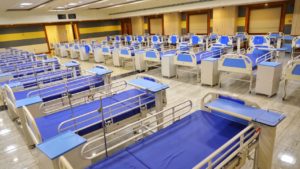 By April 04, the 4th COVID-19 hospital was operational at Rourkela in the Sundargarh District with a 200-bed capacity. The Ministry of Petroleum and Natural Gas, Government of India, provided support to open another 500-bed COVID-19 hospital.
By April 04, the 4th COVID-19 hospital was operational at Rourkela in the Sundargarh District with a 200-bed capacity. The Ministry of Petroleum and Natural Gas, Government of India, provided support to open another 500-bed COVID-19 hospital.
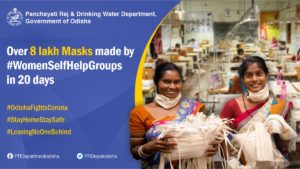 Self-Help Groups under Mission Shakti took up the initiatives of running mobile dry ration and vegetable supply in different parts of Odisha. During the lockdown, Odisha government ensured around 3.3 crore beneficiaries covered under Food Security Schemes, are provided 5.65 MT rice and wheat in advance for April, May and June.
Self-Help Groups under Mission Shakti took up the initiatives of running mobile dry ration and vegetable supply in different parts of Odisha. During the lockdown, Odisha government ensured around 3.3 crore beneficiaries covered under Food Security Schemes, are provided 5.65 MT rice and wheat in advance for April, May and June.
During the second and third week of April, the significant steps taken by the State government were:
- April 7: CM launched a telemedicine helpline number 14410 and appealed to doctors to volunteer for this purpose. Sarpanchas in the Tribal areas went door to door to demonstrate proper handwashing.
- April 7: Indian Air force airlifted personnel and medical equipment from Delhi to set up medical labs and other facilities in Odisha.
- April 9: Cabinet decided to extend the lockdown period up to April 30 and recommended the Union Govt to do so too. Odisha was the first state to do this.
- April 10: CM advised all private educational institutions to be sympathetic in considering the reduction/deferment of school fees from April to June.
- April 10: MKCG medical college and hospital, Berhampur was permitted by the ICMR to conduct COVID-19 testing
- April 15: CM announced the setting up of COVID-19 hospitals in every district with a plan to set up 36 hospitals with a combined bed capacity of 6000. CM directed the commencement of testing at VIMSAR, Burla.
- April 16: To address the drinking water crisis during summer, toll-free helpline numbers were launched for urban and rural areas.
- April 16: School and Mass Education department ensured doorstep delivery of textbooks for students of class I to VIII.
- April 16: Commissionerate Police, Bhubaneswar and Cuttack shared contact directory of police officials for home delivery of essential goods in these two cities.
- April 18: A 100 crore Urban Wage Employment Initiative was launched to generate employment for the urban poor. This would benefit 4.5 lakh families in 114 Urban Local Bodies (ULBs). Under this initiative, various labour-intensive works would be undertaken in ULBs till September. The work will be undertaken in collaboration with Mission Shakti and dues will be credited to beneficiary accounts directly, every week.
- April 19: CM addressed the migrant workers stranded outside Odisha. CM announced a proactive, humane and scientific approach to facilitate the return of people of Odisha after restrictions are lifted. This would be done through community-based monitoring systems involving Gram Panchayats and ULBs. To implement this effectively, and with a humane touch, in a historic decision, the government of Odisha delegated the powers of the district collectors to Sarpanchs in Gram Panchayats within their jurisdiction. Those who want to return to Odisha must register before they return. Relatives and friends can register with the Gram Panchayat. Returnees will stay free of cost in quarantine facilities for 14 days. On completion of the quarantine period, they will be given Rs 2000 as an incentive.
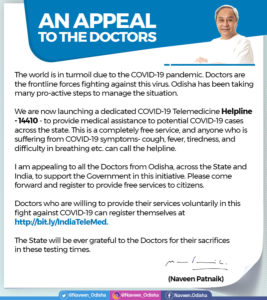
The state was able to set up five standalone COVID-19 hospitals with a combined bed capacity of 825, readied in record 30 days by April 20. Odisha became the first state to have dedicated COVID-19 hospitals in each of its districts with a cumulative 5100+ beds by April 22.
The state set up an inter-ministerial committee to look into issues of industries and MSMEs (Micro, Small and Medium Enterprises) during the current pandemic situation and recommend appropriate suggestions for bringing them back on track. Also, to cover the life risks of health workers fighting against COVID-19, the CM announced to pay Rs 50 lakh compensation in case of death during duty. Besides, the state decided to consider them as martyrs and give them state honour. Odisha is the first state in the country to do so. This announcement came on the next day when the people threw stones on an ambulance carrying the dead body of a doctor in Tamil Nadu, who died while treating COVID-19 patients. Also, the media personnel engaged in this situation are being provided with a cover of Rs 15 lakh compensation if there is a loss of life.
Realising the importance of WhatsApp as a social media platform that reaches the maximum population, on April 22, Odisha launched a WhatsApp helpdesk for disseminating information on various measures taken by the state government to contain the pandemic. It can be activated by sending Hi on the number 9337929000.
Odisha became the first state to make its post lockdown plan. The state estimated that nearly five lakh migrant workers who are stranded in different states will return home after the lockdown. Considering this, the state decentralized its functioning and activated the PRI machinery and involved all sarpanchs in planning. On 22 April, nearly 6700 sarpanchs were asked to take an oath to take care of migrant labourers on their return. Also, Odisha Livelihood Mission banking correspondents reached out to remote villages to provide banking services during the lockdown.
With an increase in testing, new cases started getting identified and the state extended complete shutdown to more locations. On April 23, the government announced a 60-hour complete shutdown in Baleswar, Bhadrak and Jajpur to knockdown COVID-19. It remained in force from 10 PM on April 23 till 10 AM of April 26, Sunday. During the shutdown, all GPs and ULBs launched a massive operation to enlist people who may have travelled from outside the state. During the shutdown, all offices, shops and establishments remained close except essential services.
To handle the migrant workers’ issue, on April 27, the state government assigned senior IAS officers to all districts as observers for effective management of their return. It should be noted that since the announcement of the COVID-19 as a state disaster, the executive takes up the responsibility and all the officers are deployed to manage COVID-19 adjourning their original responsibilities. The CM requested the PM to announce a standard operating procedure for the movement of migrant workers.
Keeping in mind the upcoming Kharif season, on April 28 the state government announced the provision of Rs 7,500 crore agricultural loans to farmers with priority to marginal and small farmers. The amount will be directly transferred to the beneficiaries’ accounts.
Understanding the prompt response of the State and people
The October 29,1999 super cyclone was the turning point for Odisha in disaster management. The super cyclone not only took more than 10, 000 precious human lives but also caused enormous economic losses. The warning to people came late. Neither the State not the people could predict the severity of the disaster. Therefore, even though there was an attempt at the last moment to evacuate people to safe places, there was very little cooperation from the people. Due to lack of experience, post-disaster management was also poor. There was a lack of coordination among various agencies. There was a huge amount of corruption in relief distribution and reconstruction work. Due to public resentment of the post-disaster management, the ruling Congress party had to replace the incumbent Chief Minister, Shri Giridhar Gamang and induct Shri Hemananda Biswal as the new CM in December. However, Shri Hemananda Biswal’s government could not last even 100 days. In March 2000, Naveen Pattanaik came to power in coalition with the Bhartiya Janata Party.
The first challenge for the new government was to provide relief to the affected families and reconstruct cyclone-hit coastal Odisha. The painful memory of 1999 super cyclone has neither faded away from the hearts and minds of the people of Odisha nor from that of the political parties and bureaucracy. The institutional memory and public memory regarding the possible consequences play a very important role in Odisha to respond effectively to any kind of disaster. The present health disaster, COVID 19, also has prompted Odisha to respond swiftly. Once the state announces a disaster as ‘state disaster’, the entire administrative machinery suspends its routine business and takes up the single task to mitigate the effects of the disaster and save the lives of people. In this process, the executive wing takes over disaster management. In a recent press meet, one of the secretaries told that at present, there are no departmental secretaries; all secretaries are COVID secretaries.
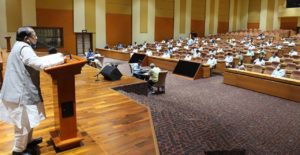 A Cabinet meeting on preparedness underway.
A Cabinet meeting on preparedness underway.
Challenges ahead
Managing Migrant Workers
The state is preparing to bring home more than 5 lakh Odia labourers stranded in different states; the preparedness needs to match the need. Though the state government has already directed all Gram Panchayats to set up quarantine wards, the facilities may still not be enough. Including all Panchayats, the quarantine facilities are sufficient for around 2.5 lakh people, whereas, the government of Odisha estimates that about 5 lakh out of 7.5 lakh migrant workers will return. This situation may look graver as, by 29 March, 6 lakh migrant workers have registered with the agencies.
Besides these numbers, the state also has a risk of receiving more migrant workers as it shares a porous border with West Bengal, Jharkhand, Chhattisgarh and Andhra Pradesh and 485 km of coastline. The community will play an important role in identifying such people without registration and sending them to Panchayat-level quarantine facilities.
The CM of the state has already alerted that with migrant workers coming in, COVID-19 cases may rise and the state is fully prepared to handle it. However, the service delivery at community, village and panchayat level is critical which can be ensured by barefoot frontline health workers. The success will depend on their proper training and deployment.
Compared to other states, Odisha has been largely able to control the spread of COVID-19 and has responded to it in a proactive manner. But, post softening of lockdown after May 3, the restrictions on inter- and intra-state movement need to cautiously laid-out so that the successful efforts carried out till date do not get lost.
Unemployment
Around 10 lakh migrant workers may return to the state from other states and countries very soon. Many of them may not return to their work outside the state or country for fear of the pandemic. Added to this would be the loss of livelihoods due to the suspension of construction activities and loss of jobs in MSMEs within the state. The pre-COVID unemployment rate of Odisha was higher than the national average and the highest in the country. In this context, the state would face the daunting task of providing employment opportunities to so many people.
Non-COVID health risks
Odisha’s health infrastructure and health sector manpower are inadequate. At present, the entire health manpower is engaged in the fight against COVID-19. In such a situation, people suffering from chronic diseases and other ailments are deprived of healthcare facilities. There are also media reports of people dying without getting medical attention either in public or private sectors. Therefore, the state needs to increase the manpower in the health sector and improve health infrastructure.
Conclusion
The state has shown some first of its kind actions to handle the COVID-19 pandemic. This could be seen as the state’s learning from handling natural disasters2 year after year. During and post these disasters, the state has already been credited with management resulting in zero human and cattle loss. The same passion, commitment, proactiveness is visible in its fight against the COVID-19 pandemic.
AUTHORS
Amarendra Das, Reader-F, School of Humanities and Social Sciences, National Institute for Science Education and Research (NISER), Bhubaneswar. Email: amarendra@niser.ac.in
Subrat K Mishra, Program Manager, Field Practice and Students Affairs, Azim Premji University.
Disclaimer: The views and opinions expressed in this article are those of the author/s and do not necessarily reflect the official policy or position of Azim Premji University or Foundation.

